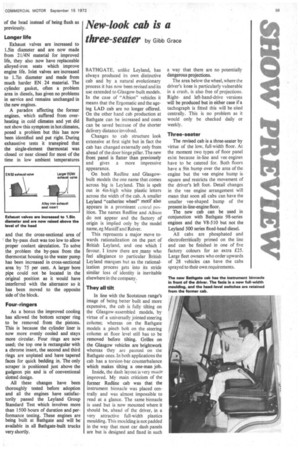New-look cab is a
Page 63

If you've noticed an error in this article please click here to report it so we can fix it.
three-seater by Gibb Grace
BATHGATE, unlike Leyland, has always produced its own distinctive cab and by a natural evolutionary process it has now been revised and its use extended to Glasgow-built models. In the case of "Albion" vehicles it means that the Ergomatic and the ageing LAD cab are no longer offered. On the other hand cab production at Bathgate can be increased and costs can be saved because of the shorter delivery distance involved.
Changes to cab structure look extensive at first sight but in fact the cab has changed externally only from ahead of the door hinge pillar. The new front panel is flatter than previously and gives a more impressive appearance.
On both Redline and Glasgowbuilt models the one name that comes across big is Leyland. This is spelt out in 4in-high white plastic letters across the width of the cab. A smaller Leyland "catherine wheel" motif also appears in a prominent central position. The names Redline and Albion do not appear and the factory of origin is implied only by the model name, eg Mastiff and Reiver.
This represents a major move towards rationalization on the part of British Leyland, and one which I favour. I know there are many who feel allegiance to particular British Leyland marques but as the rationalization process gets into its stride similar loss of identity is inevitable elsewhere in the company.
They all tilt In line with the Seotstouri range's image of being better built and more expensive, the cab is fully tilting on the Glasgow-assembled models, by virtue of a universally jointed steering column; whereas on the Bathgate models a pinch bolt on the steering column at floor level still has to be removed before tilting. Grilles on the Glasgow vehicles are brightwork whereas they are painted on the Bathgate ones. In both applications the cab has a torsion-bar counterbalance which makes tilting a one-man job.
Inside, the dash layout is very muchimproved. My main criticism of the former Redline cab was that the instrument binnacle was placed centrally and was almost impossible to read at a glance. The same binnacle is used but is now mounted where it should be, ahead of the driver, in a very attractive full-width plastics moulding. This moulding is not padded in the way that most car dash panels are but is designed and fixed in such a way that there are no potentially dangerous projections.
The area below the wheel, where the driver's knee is particularly vulnerable in a crash, is also free of projections. Rightand left-hand-drive versions will be produced but in either case if a tachograph is fitted this will be sited centrally. This is no problem as it would only be checked daily or weekly,
Three-seater
The revised cab is a three-seater by virtue of the low, full-width floor. At the moment two types of floor panel exist because in-line and vee engines have to be catered for. Both floors have a 9in hump over the area of the engine but the vee engine hump is square and restricts the movement of the driver's left foot. Detail changes in the vee engine arrangement will mean that soon all cabs can have the smaller vee-sh aped hump of the present in-line-engine floor.
The new cab can be used in conjunction with Bathgate 98-series engines and the V8-510 but not the Leyland 500 series fixed-head diesel.
All cabs are phosphated and electroferritically primed on the line and can be finished in one of five factory colours for an extra £25. Large fleet owners who order upwards of 28 vehicles can have the cabs sprayed to their own requirements.
























































































































